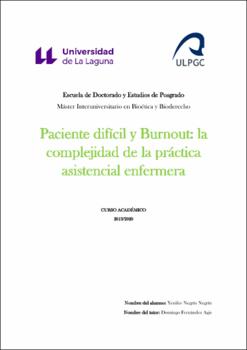Paciente difícil y Burnout: la complejidad de la práctica asistencial enfermera
Autor
Negrín Negrín, YeniferFecha
2021Resumen
Objetivo: Establecer una relación entre el trato con pacientes difíciles y su predisposición
a desarrollar el síndrome de Burnout en el personal de enfermería.
Metodología: Estudio descriptivo transversal en el que se ha utilizado un cuestionario de
elaboración propia para la obtención de datos de los profesionales de enfermería. La
recogida de datos se ha realizado durante el mes de abril de 2020, mediante la plataforma
digital www.onlineencuesta.com. En total se han obtenido unos 150 cuestionarios de los
cuales 133 se han incluido en el estudio. Los encuestados han sido enfermeros en activo
que desempeñaran cualquiera de las competencias de su profesión (asistencial, docente y
gestora).
Resultados: El 63,1% de la muestra fueron mujeres, casi el doble que los hombres
participantes (36,8%) con edades comprendidas entre los 22 y los 61 años. Todos ellos
ejercían activamente la enfermería en sus distintas vertientes: asistencial (93,2%),
docente (0,75%) y gestora (6,01%). El 96,99% de los encuestados afirmó haber
identificado a algún paciente difícil durante su práctica asistencial y un 71,42% afirmó
haber sufrido algún tipo de cambio en su manera de trabajar al tener que relacionarse con
estos pacientes. Más del 90% de los participantes (91,73%) confirmó haber sufrido una
sobrecarga asistencial al tener que lidiar con pacientes difíciles en su ámbito laboral y el
52,63% afirmaba no sentirse adecuadamente formado para poder afrontar la relación
profesional-paciente (difícil). El tratamiento multidisciplinar fue el elegido por la mayor
parte de la muestra (95,49%) y finalmente, el 93,24% de los enfermeros confirmaron la
hipótesis propuesta en el estudio, en la que se relaciona la sobrecarga asistencial, el trato
con pacientes difíciles y la predisposición a sufrir el síndrome de Burnout.
Discusión: Se ha confirmado la existencia de los pacientes difíciles en el sistema sanitario
y su relación con el aumento de estrés y ansiedad en el personal de enfermería. Por otro
lado, se ha planteado sustituir la nomenclatura de “paciente difícil” por la de “relación
difícil” en la que ambos componentes de la relación (profesional y paciente) comparten
responsabilidades. Además, se ha destacado la necesidad de implementar un plan de
estudios que contemple las técnicas de comunicación como pilar esencial. Objective: To establish a relationship between dealing with difficult patients and their
predisposition to develop Burnout syndrome in nursing staff.
Methodology: Cross-sectional descriptive study in which a self-prepared questionnaire
was used to obtain data from nursing professionals. The data collection was carried out
during the month of April 2020, through the digital platform www.onlineencuestas.com.
In total, some 150 questionnaires have been obtained, of which 133 have been included
in the study. The respondents have been active nurses who carry out any of the
competences of their profession (healthcare, teaching and management).
Results: 63.1% of the sample are women, almost twice as many as the participating men
(36.8%) with ages between 22 and 61 years. All of them actively practiced nursing in its
different aspects: healthcare (93.2%), teacher (0.75%) and manager (6.01%). 96.99% of
those surveyed stated that they had identified a difficult patient during their healthcare
practice and 71.42% stated that they had undergone some type of change in their way of
working as they had to relate to these patients. More than 90% of the participants
(91.73%) confirmed having suffered an overload of care when having to deal with
difficult patients in their workplace and 52.63% stated that they did not feel adequately
trained to be able to face the professional-patient relationship (hard). The
multidisciplinary treatment was chosen by the majority of the sample (95.49%) and
finally, 93.24% of the nurses confirmed the hypothesis proposed in the study, which
relates to care overload, treatment with difficult patients and the predisposition to suffer
from Burnout syndrome.
Discussion: The existence of difficult patients in the health system and its relationship
with increased stress and anxiety in nursing staff have been confirmed. On the other hand,
it has been proposed to replace the nomenclature of "difficult patient" with that of
"difficult relationship" in which both components of the relationship (professional and
patient) share responsibilities. Furthermore, the need to implement a study plan that
considers communication techniques as an essential pillar has been highlighted.




